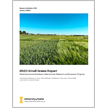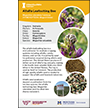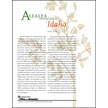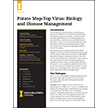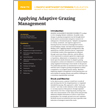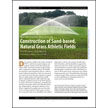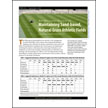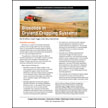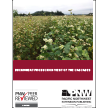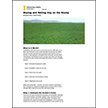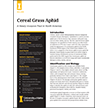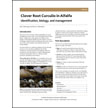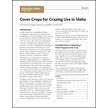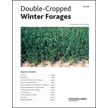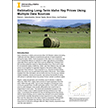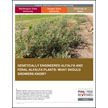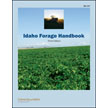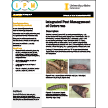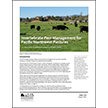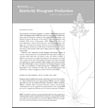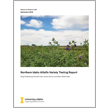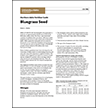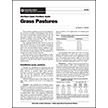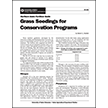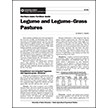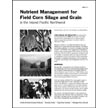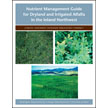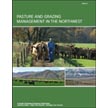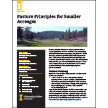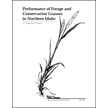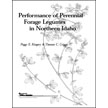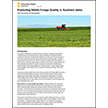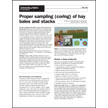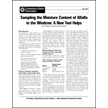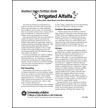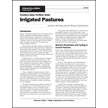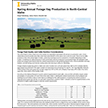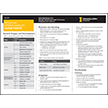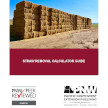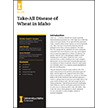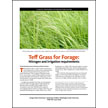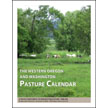Forage Crops and Pasture
Packed with tons of agronomic data, disease ratings and end-use quality data — interspersed with reports about planting and weather conditions, insect and diseases issues and more. This 146-page...
The alfalfa leafcutting bee is a vital pollinator for multiple cropping systems, including alfalfa, canola, melons and carrots. This information card provides basic facts about and photographs of...
This publication offers information for the alfalfa grower on various parasitic nematodes that affect their crops. It covers the distribution, life cycle, symptoms, impact and management strategies...
Answers to Common Questions about Greenhouse Gases
Because climate change is one of the most urgent issues of our time, meaningful public discourse about it requires a basic understanding of the types of greenhouse gases (GHGs) involved, where they...
Applying Adaptive Grazing Management
Grazing management requires flexibility to adapt to ever-changing climatic conditions, and changes in grazing management for public lands may be required because of endangered or threatened species.
Best Management Practices for Constructing Sand-based Athletic Fields for Football and Soccer
Sand-based, natural turfgrass and synthetic surfaces are the best options for athletic fields in the rainy Pacific Northwest. Sand-based, natural turfgrass fields, when compared to synthetic...
Best Management Practices for Maintaining Sand-based Natural Grass Athletic Fields
This publication recommends specific ways to manage sand-based fields, which will require more frequent fertilization, irrigation and cultivation for proper maintenance than native soil fields.
Biosolids in Dryland Cropping Systems
This publication reviews the long term benefits of municipal biosolids applications on soil health in dryland cereal and pasture cropping systems east of the Cascades. Biosolids were an especially...
Buckwheat Production West of the Cascades
Naturally gluten-free, buckwheat has a variety of culinary uses regionally and internationally. Learn about market opportunities, how to establish a strong stand, and the best management and...
Buying and Selling Hay on the Stump
This publication provides a five-step process and lists several online business tools that will empower buyers and sellers to successfully establish a fair price for hay on the stump. The steps...
Cereal Grass Aphid: A Newly Invasive Pest in North America
Cereal grass aphid is a newly invasive aphid pest in North America. It colonizes cultivated crops like wheat, barley and oat, sucking their juices and using them as host sites for reproduction,...
Chemical Weed Control in New Spring-Seeded Alfalfa
Weed management is one of the most important practices in alfalfa production, particularly in new seeding. This bulletin briefly discusses two chemical-based approaches: preemergence or preplant...
Clover Root Curculio in Alfalfa: Identification, Biology, and Management
This publication helps growers in Idaho, Oregon and Washington to identify clover root curculio infestations and to design an Integrated Pest Management (IPM) program for managing clover root...
Cover Crops for Grazing Use in Idaho
This publication will help crop and livestock producers in Idaho or other high-desert systems to select, plant, and manage cover crop species and mixtures that can also serve as livestock forage.
Double cropping winter forages with corn silage increases total forage available to livestock operations while also removing more phosphorus from the soil. This 13-page bulletin with 14 figures...
Estimating Long-Term Idaho Hay Prices Using Multiple Data Sources
The dairy industry can substantially affect markets for other agricultural commodities, particularly those like alfalfa hay, which is used in dairy feed. In other words, hay and milk prices move...
Genetically Engineered Alfalfa and Feral Alfalfa Plants: What Should Growers Know?
Alfalfa is the world's most important forage crop, and the western U.S. is its most important production area. Feral alfalfa is common and can potentially lower the genetic purity of alfalfa seed...
Idaho Forage Handbook (third edition)
This comprehensive information source for anyone who grows forage in Idaho or neighboring states covers topics from species and variety selection to pest control to harvest management, hay storage...
Inland Pacific Northwest Pasture Calendar
The Inland PNW Pasture Calendar is a comprehensive guide intended to help improve grassland management of forage-livestock systems in the region. From eight chapters and eighteen appendices, learn...
Integrated Pest Management of Cutworms
Insect and disease pests are prevalent in both residential and commercial food production settings, meaning that a large number of Idahoans contend with them each year. Part of an integrated pest...
Invertebrate Pest Management for Pacific Northwest Pastures
Several species of insects (arthropods and gastropods) live in pastures of the Pacific Northwest, but unfortunately many of them can reduce its productivity. This well-illustrated publication...
Italian Ryegrass Management in Inland Pacific Northwest Dryland Cropping Systems
Widespread herbicide resistance in Italian ryegrass makes integrated weed management strategies difficult for this problematic weed. Learn about the multiple control methods and their combination...
Eliminating burning in the production of Kentucky bluegrass seed to alleviate public health concerns will greatly impact production of this crop, 90 percent of which is produced in Idaho,...
Northern Idaho Alfalfa Variety Testing Report
Thirty-three varieties of alfalfa were field-tested in University of Idaho Extension variety trials conducted in northern Idaho during 2013–2016 crop seasons. The variety trials were located in...
Northern Idaho Fertilizer Guide: Bluegrass Seed
Fertilizer improves plant growth and productivity. An entry in the northern Idaho Fertilizer Guide series, this four-page publication offers fertilizer guidelines for nitrogen, phosphorus,...
Northern Idaho Fertilizer Guide: Grass Pastures
Fertilizer improves plant growth and productivity. An entry in the northern Idaho Fertilizer Guide series, this three-page publication offers fertilizer guidelines for established grass pastures...
Northern Idaho Fertilizer Guide: Grass Seedings for Conservation Programs
Fertilizer improves plant growth and productivity. An entry in the northern Idaho Fertilizer Guide series, this three-page publication offers fertilizer guidelines for lime and nitrogen,...
Northern Idaho Fertilizer Guide: Legume and Legume-Grass Pastures
Fertilizer improves plant growth and productivity. An entry in the northern Idaho Fertilizer Guide series, this three-page publication offers fertilizer guidelines for established nonirrigated...
Nutrient Management for Field Corn Silage and Grain
Adequate nutrition is essential if productive new corn hybrids are to realize their full yield potential. This publication provides fertilizer guidelines based on university research and a special...
Nutrient Management Guide for Dryland and Irrigated Alfalfa in the Inland Northwest
This full-color illustrated guide for optimizing alfalfa production according to the growing conditions common throughout Idaho and east of the Cascades in Oregon and Washington provides specific...
Pasture and Grazing Management in the Northwest
$35 The comprehensive resource for anyone who manages livestock on pastures in the Northwest, this 214-page book offers pasture managers information and tools to enable their pastures and their...
Pasture Principles for Smaller Acreages
Ranchettes and small farms are cropping up in rural landscapes across Idaho, spurring demand for information on pasture management. This updated publication addresses the most common concerns...
Performance of Forage and Conservation Grasses in Northern Idaho
This publication summarizes the methods and results of two University of Idaho multi-year grass studies that aimed to evaluate the productivity of various perennial, cool-season grasses for...
Performance of Perennial Forage Legumes in Northern Idaho
This publication summarizes the methods and results of a University of Idaho study that collected data from three growing seasons and assessed the productivity, seasonal growth distribution and...
Predicting Alfalfa Forage Quality in Southern Idaho
So that growers can meet certain goals or marketing criteria, it's important to know how to determine the quality of alfalfa hay. Indeed, producers who raise dairy quality hay can expect higher...
Proper Sampling (Coring) of Hay Bales and Stacks
Bad nutrition diminishes any herd's productivity. Forage sampling is thus a key strategy that helps livestock producers to maintain or optimize their operation's output. This four-page bulletin...
Sampling the Moisture Content of Alfalfa in the Windrow: A New Tool Helps
Production of high-quality hay is vital for the dairy industry. Because forage moisture content determines its quality, producers need to know how to accurately measure the amount of water in...
Southern Idaho Fertilizer Guide: Irrigated Alfalfa
Fertilizer improves plant growth and productivity. An entry in the southern Idaho Fertilizer Guide series, this four-page publication offers fertilizer guidelines for nitrogen, phosphorus,...
Southern Idaho Fertilizer Guide: Irrigated Pastures
Irrigated pastures in southern Idaho are primarily composed of grasses or grass-legume mixtures. An entry in the southern Idaho Fertilizer Guide series, this five-page publication explains the...
Spring Annual Forage Hay Production in North-Central Idaho
Cattle producers in north-central Idaho need quality feed for their herds. But to satisfy that need, you need to do your homework. This publication helps growers and cattlemen understand how to use...
Spring Barley Quick Facts (2015 Southern Idaho)
This two-page fact sheet offers recommendations for growing spring barley in southern Idaho, with pointers or information on growth stages and development, rotation and seeding, irrigation,...
Straw Removal Calculator Guide
Straw removal has become a widespread practice in dryland wheat production in the inland Pacific Northwest. Although straw harvest may provide short-run economic benefits, it also can incur hidden...
Take-All Disease of Wheat in Idaho
Take-all is a highly destructive fungal disease of cereals whose ability to infect multiple plant parts often results in a crop’s complete destruction. Mainly found in wheat, barley, rye and...
Teff Grass for Forage: Nitrogen and irrigation requirements
Teff is an ancient grain, made popular recently as more growers turn to teff for its high yields of high-quality hay. New research outlined here shows that teff requires less nitrogen fertilizer...
The Western Oregon and Washington Pasture Calendar
This publication describes, by climatic zone, perennial pasture plant growth and how management actions can affect growth, both positively and negatively. Optimal management of forages by season is...







